Marketing and Management: Case Study Analysis of Coca Cola's Communication Mix for Beijing and London Olympics
VerifiedAdded on 2023/06/15
|10
|2786
|230
AI Summary
This case study analysis explores Coca Cola's communication mix for the Beijing and London Olympics, including their television advertising, outdoor communication, on-pack communication, online and interactive communication, packaging and merchandise, sales promotions, and public relations. The article also highlights the differences between the marketing strategies of the two years and the unique elements of Coca Cola's London Olympic campaign.
Contribute Materials
Your contribution can guide someone’s learning journey. Share your
documents today.
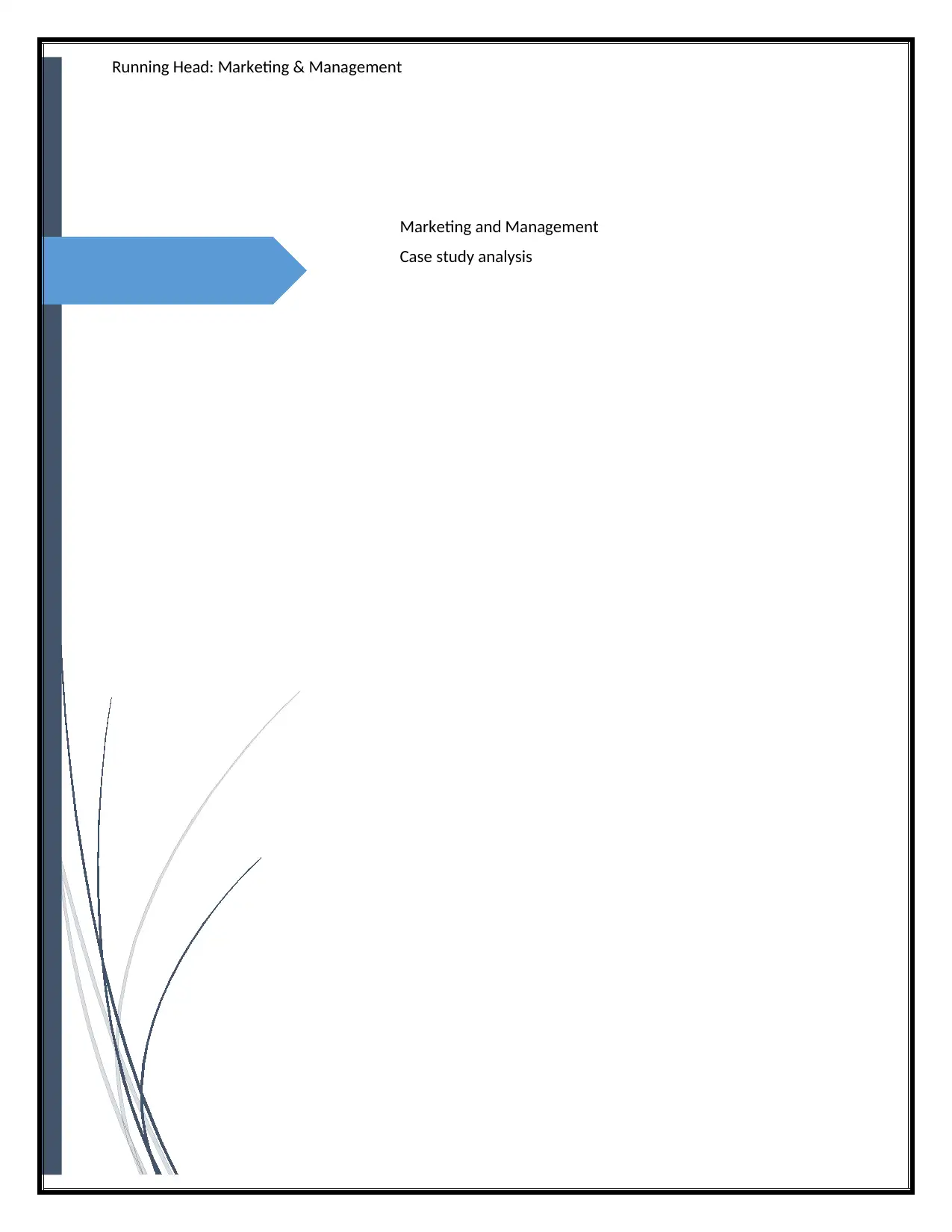
Running Head: Marketing & Management
Marketing and Management
Case study analysis
Marketing and Management
Case study analysis
Secure Best Marks with AI Grader
Need help grading? Try our AI Grader for instant feedback on your assignments.
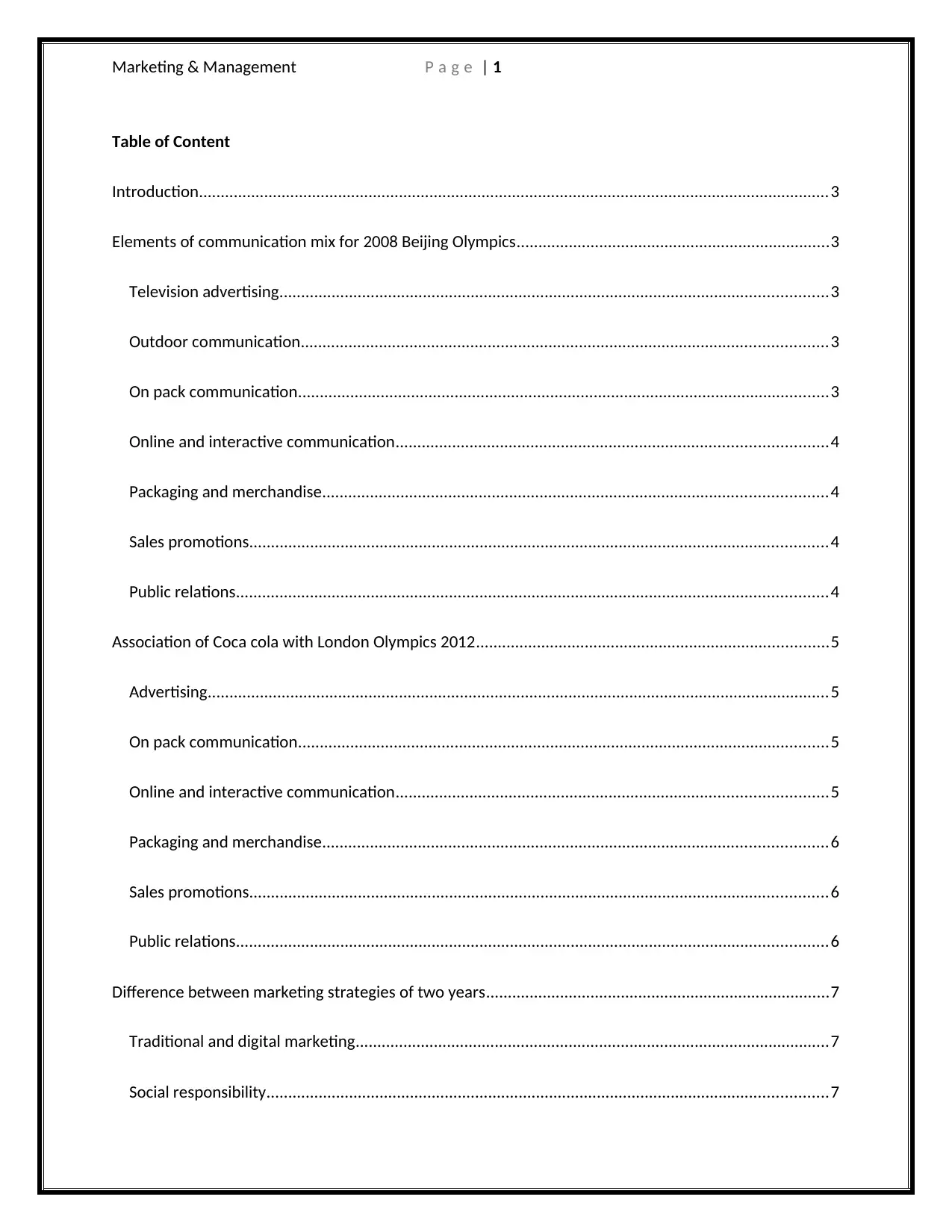
Marketing & Management P a g e | 1
Table of Content
Introduction.................................................................................................................................................3
Elements of communication mix for 2008 Beijing Olympics........................................................................3
Television advertising..............................................................................................................................3
Outdoor communication.........................................................................................................................3
On pack communication..........................................................................................................................3
Online and interactive communication...................................................................................................4
Packaging and merchandise....................................................................................................................4
Sales promotions.....................................................................................................................................4
Public relations........................................................................................................................................4
Association of Coca cola with London Olympics 2012.................................................................................5
Advertising...............................................................................................................................................5
On pack communication..........................................................................................................................5
Online and interactive communication...................................................................................................5
Packaging and merchandise....................................................................................................................6
Sales promotions.....................................................................................................................................6
Public relations........................................................................................................................................6
Difference between marketing strategies of two years...............................................................................7
Traditional and digital marketing.............................................................................................................7
Social responsibility.................................................................................................................................7
Table of Content
Introduction.................................................................................................................................................3
Elements of communication mix for 2008 Beijing Olympics........................................................................3
Television advertising..............................................................................................................................3
Outdoor communication.........................................................................................................................3
On pack communication..........................................................................................................................3
Online and interactive communication...................................................................................................4
Packaging and merchandise....................................................................................................................4
Sales promotions.....................................................................................................................................4
Public relations........................................................................................................................................4
Association of Coca cola with London Olympics 2012.................................................................................5
Advertising...............................................................................................................................................5
On pack communication..........................................................................................................................5
Online and interactive communication...................................................................................................5
Packaging and merchandise....................................................................................................................6
Sales promotions.....................................................................................................................................6
Public relations........................................................................................................................................6
Difference between marketing strategies of two years...............................................................................7
Traditional and digital marketing.............................................................................................................7
Social responsibility.................................................................................................................................7
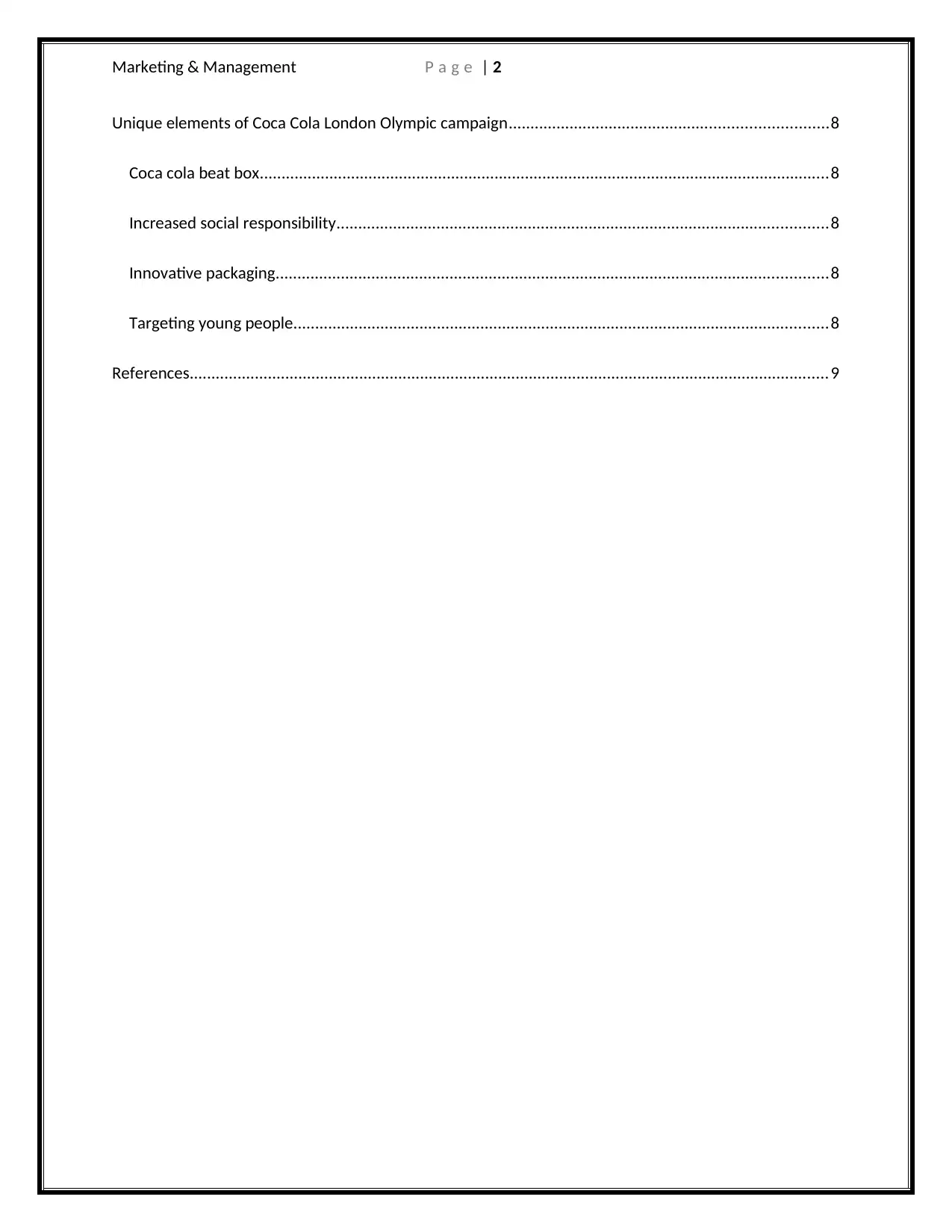
Marketing & Management P a g e | 2
Unique elements of Coca Cola London Olympic campaign.........................................................................8
Coca cola beat box...................................................................................................................................8
Increased social responsibility.................................................................................................................8
Innovative packaging...............................................................................................................................8
Targeting young people...........................................................................................................................8
References...................................................................................................................................................9
Unique elements of Coca Cola London Olympic campaign.........................................................................8
Coca cola beat box...................................................................................................................................8
Increased social responsibility.................................................................................................................8
Innovative packaging...............................................................................................................................8
Targeting young people...........................................................................................................................8
References...................................................................................................................................................9

Marketing & Management P a g e | 3
Introduction
Elements of communication mix for 2008 Beijing
Olympics
Television advertising
Coca cola has been always at its helm when it comes to advertising, the company’s long association with
the Olympics further propelled the company to come up with creative advertising. The campaign was
focused on how coca cola and Olympics are bringing people close to each other. Coca cola came up with
three brilliant advertisements reflecting great positive moments of life. The advertisement relished the
long standing 80 years of association between Coca-Cola and the Olympics. It was definitely a sight to
see, filled with emotions and lot of earlier achievements and historical footage; it sure was a great
campaign. At the same time, Coca Cola also targeted the Chinese market and crafted advertisement for
Chinese people (Soderman & Dolles, 2008)
Outdoor communication
Coca-Cola’s outdoor campaign was reflective of its branding, the company came up with painting of bus
shelters and painting on major streets, the painting symbolized bold and dark color of red and it was
written “Cool is about to arrive”. The company launched the campaign in Beijing an year before the
actual Olympics in August 2008; it was also successful in creating a good buzz in Beijing (Fullerton &
Merz, 2008)
On pack communication
The Beijing campaign was launched by the on pack communication, Coca –Cola launched a new
composite logo and a cool innovative bottle for Olympics. The new logo was designed keeping in mind a
flying red kite intertwined with a background of clouds; it was based on the theme of “showcasing China
to the world”. In addition to this innovative and limited edition bottle, the company also came up with a
quirky design to target its young audience (Price, 2008)
Introduction
Elements of communication mix for 2008 Beijing
Olympics
Television advertising
Coca cola has been always at its helm when it comes to advertising, the company’s long association with
the Olympics further propelled the company to come up with creative advertising. The campaign was
focused on how coca cola and Olympics are bringing people close to each other. Coca cola came up with
three brilliant advertisements reflecting great positive moments of life. The advertisement relished the
long standing 80 years of association between Coca-Cola and the Olympics. It was definitely a sight to
see, filled with emotions and lot of earlier achievements and historical footage; it sure was a great
campaign. At the same time, Coca Cola also targeted the Chinese market and crafted advertisement for
Chinese people (Soderman & Dolles, 2008)
Outdoor communication
Coca-Cola’s outdoor campaign was reflective of its branding, the company came up with painting of bus
shelters and painting on major streets, the painting symbolized bold and dark color of red and it was
written “Cool is about to arrive”. The company launched the campaign in Beijing an year before the
actual Olympics in August 2008; it was also successful in creating a good buzz in Beijing (Fullerton &
Merz, 2008)
On pack communication
The Beijing campaign was launched by the on pack communication, Coca –Cola launched a new
composite logo and a cool innovative bottle for Olympics. The new logo was designed keeping in mind a
flying red kite intertwined with a background of clouds; it was based on the theme of “showcasing China
to the world”. In addition to this innovative and limited edition bottle, the company also came up with a
quirky design to target its young audience (Price, 2008)
Secure Best Marks with AI Grader
Need help grading? Try our AI Grader for instant feedback on your assignments.
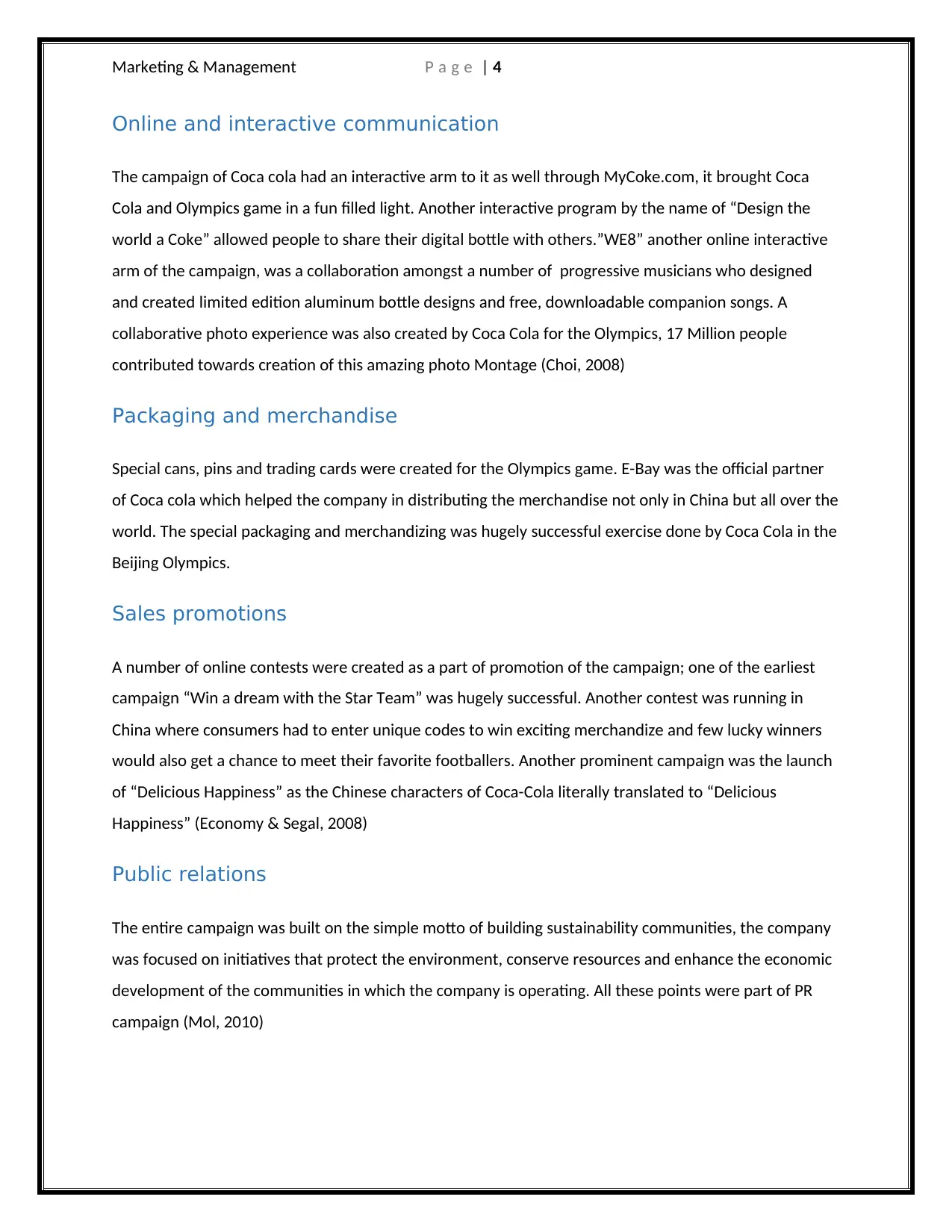
Marketing & Management P a g e | 4
Online and interactive communication
The campaign of Coca cola had an interactive arm to it as well through MyCoke.com, it brought Coca
Cola and Olympics game in a fun filled light. Another interactive program by the name of “Design the
world a Coke” allowed people to share their digital bottle with others.”WE8” another online interactive
arm of the campaign, was a collaboration amongst a number of progressive musicians who designed
and created limited edition aluminum bottle designs and free, downloadable companion songs. A
collaborative photo experience was also created by Coca Cola for the Olympics, 17 Million people
contributed towards creation of this amazing photo Montage (Choi, 2008)
Packaging and merchandise
Special cans, pins and trading cards were created for the Olympics game. E-Bay was the official partner
of Coca cola which helped the company in distributing the merchandise not only in China but all over the
world. The special packaging and merchandizing was hugely successful exercise done by Coca Cola in the
Beijing Olympics.
Sales promotions
A number of online contests were created as a part of promotion of the campaign; one of the earliest
campaign “Win a dream with the Star Team” was hugely successful. Another contest was running in
China where consumers had to enter unique codes to win exciting merchandize and few lucky winners
would also get a chance to meet their favorite footballers. Another prominent campaign was the launch
of “Delicious Happiness” as the Chinese characters of Coca-Cola literally translated to “Delicious
Happiness” (Economy & Segal, 2008)
Public relations
The entire campaign was built on the simple motto of building sustainability communities, the company
was focused on initiatives that protect the environment, conserve resources and enhance the economic
development of the communities in which the company is operating. All these points were part of PR
campaign (Mol, 2010)
Online and interactive communication
The campaign of Coca cola had an interactive arm to it as well through MyCoke.com, it brought Coca
Cola and Olympics game in a fun filled light. Another interactive program by the name of “Design the
world a Coke” allowed people to share their digital bottle with others.”WE8” another online interactive
arm of the campaign, was a collaboration amongst a number of progressive musicians who designed
and created limited edition aluminum bottle designs and free, downloadable companion songs. A
collaborative photo experience was also created by Coca Cola for the Olympics, 17 Million people
contributed towards creation of this amazing photo Montage (Choi, 2008)
Packaging and merchandise
Special cans, pins and trading cards were created for the Olympics game. E-Bay was the official partner
of Coca cola which helped the company in distributing the merchandise not only in China but all over the
world. The special packaging and merchandizing was hugely successful exercise done by Coca Cola in the
Beijing Olympics.
Sales promotions
A number of online contests were created as a part of promotion of the campaign; one of the earliest
campaign “Win a dream with the Star Team” was hugely successful. Another contest was running in
China where consumers had to enter unique codes to win exciting merchandize and few lucky winners
would also get a chance to meet their favorite footballers. Another prominent campaign was the launch
of “Delicious Happiness” as the Chinese characters of Coca-Cola literally translated to “Delicious
Happiness” (Economy & Segal, 2008)
Public relations
The entire campaign was built on the simple motto of building sustainability communities, the company
was focused on initiatives that protect the environment, conserve resources and enhance the economic
development of the communities in which the company is operating. All these points were part of PR
campaign (Mol, 2010)
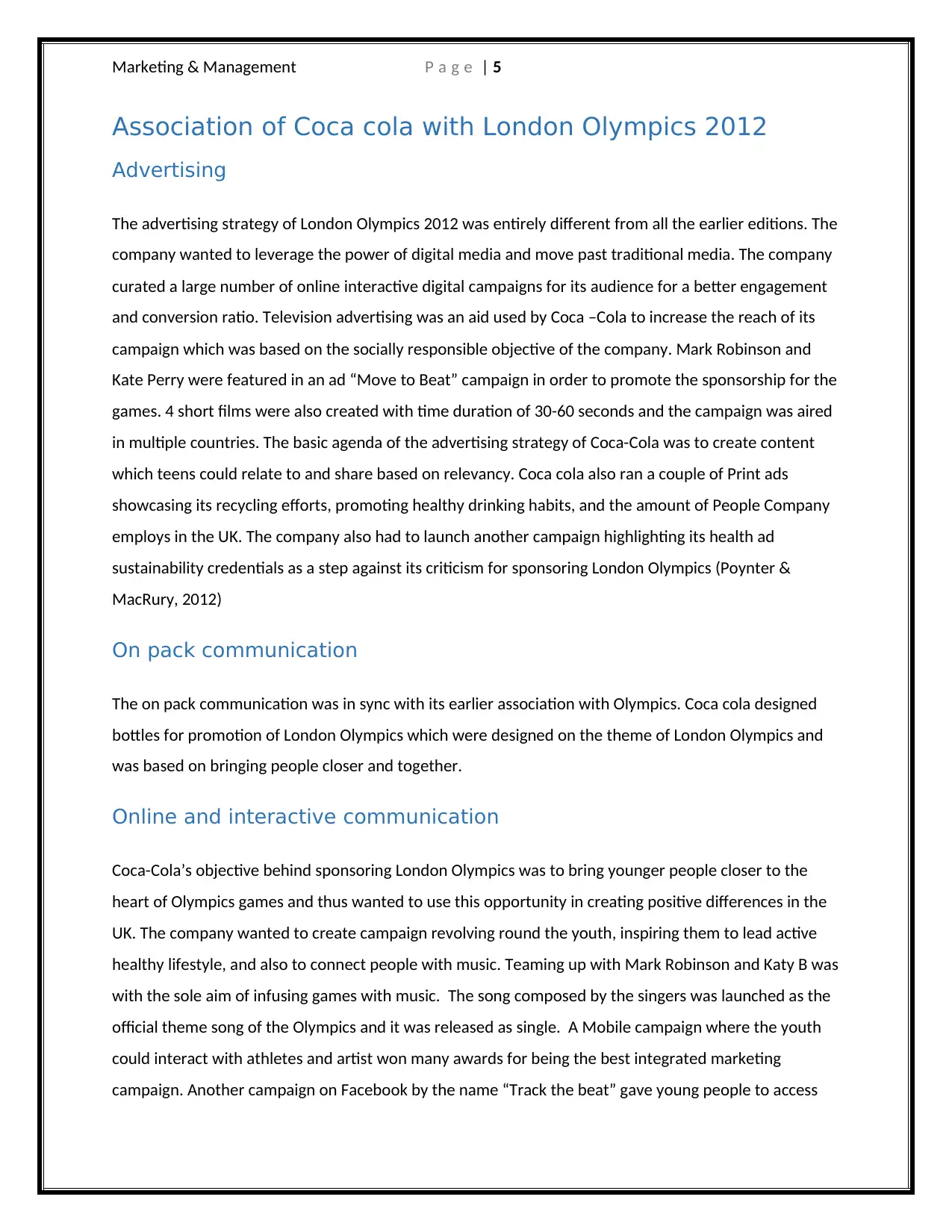
Marketing & Management P a g e | 5
Association of Coca cola with London Olympics 2012
Advertising
The advertising strategy of London Olympics 2012 was entirely different from all the earlier editions. The
company wanted to leverage the power of digital media and move past traditional media. The company
curated a large number of online interactive digital campaigns for its audience for a better engagement
and conversion ratio. Television advertising was an aid used by Coca –Cola to increase the reach of its
campaign which was based on the socially responsible objective of the company. Mark Robinson and
Kate Perry were featured in an ad “Move to Beat” campaign in order to promote the sponsorship for the
games. 4 short films were also created with time duration of 30-60 seconds and the campaign was aired
in multiple countries. The basic agenda of the advertising strategy of Coca-Cola was to create content
which teens could relate to and share based on relevancy. Coca cola also ran a couple of Print ads
showcasing its recycling efforts, promoting healthy drinking habits, and the amount of People Company
employs in the UK. The company also had to launch another campaign highlighting its health ad
sustainability credentials as a step against its criticism for sponsoring London Olympics (Poynter &
MacRury, 2012)
On pack communication
The on pack communication was in sync with its earlier association with Olympics. Coca cola designed
bottles for promotion of London Olympics which were designed on the theme of London Olympics and
was based on bringing people closer and together.
Online and interactive communication
Coca-Cola’s objective behind sponsoring London Olympics was to bring younger people closer to the
heart of Olympics games and thus wanted to use this opportunity in creating positive differences in the
UK. The company wanted to create campaign revolving round the youth, inspiring them to lead active
healthy lifestyle, and also to connect people with music. Teaming up with Mark Robinson and Katy B was
with the sole aim of infusing games with music. The song composed by the singers was launched as the
official theme song of the Olympics and it was released as single. A Mobile campaign where the youth
could interact with athletes and artist won many awards for being the best integrated marketing
campaign. Another campaign on Facebook by the name “Track the beat” gave young people to access
Association of Coca cola with London Olympics 2012
Advertising
The advertising strategy of London Olympics 2012 was entirely different from all the earlier editions. The
company wanted to leverage the power of digital media and move past traditional media. The company
curated a large number of online interactive digital campaigns for its audience for a better engagement
and conversion ratio. Television advertising was an aid used by Coca –Cola to increase the reach of its
campaign which was based on the socially responsible objective of the company. Mark Robinson and
Kate Perry were featured in an ad “Move to Beat” campaign in order to promote the sponsorship for the
games. 4 short films were also created with time duration of 30-60 seconds and the campaign was aired
in multiple countries. The basic agenda of the advertising strategy of Coca-Cola was to create content
which teens could relate to and share based on relevancy. Coca cola also ran a couple of Print ads
showcasing its recycling efforts, promoting healthy drinking habits, and the amount of People Company
employs in the UK. The company also had to launch another campaign highlighting its health ad
sustainability credentials as a step against its criticism for sponsoring London Olympics (Poynter &
MacRury, 2012)
On pack communication
The on pack communication was in sync with its earlier association with Olympics. Coca cola designed
bottles for promotion of London Olympics which were designed on the theme of London Olympics and
was based on bringing people closer and together.
Online and interactive communication
Coca-Cola’s objective behind sponsoring London Olympics was to bring younger people closer to the
heart of Olympics games and thus wanted to use this opportunity in creating positive differences in the
UK. The company wanted to create campaign revolving round the youth, inspiring them to lead active
healthy lifestyle, and also to connect people with music. Teaming up with Mark Robinson and Katy B was
with the sole aim of infusing games with music. The song composed by the singers was launched as the
official theme song of the Olympics and it was released as single. A Mobile campaign where the youth
could interact with athletes and artist won many awards for being the best integrated marketing
campaign. Another campaign on Facebook by the name “Track the beat” gave young people to access

Marketing & Management P a g e | 6
and interacts with the campaign anytime, users were also given powers to collect different beats around
the song of London Olympics and share it with their friends. Coca-Cola went in partnership with
Samsung and Android to further promote the spirit of music and game. All in all, the digital marketing
campaign was a massive hit across London (Kim, 2013)
Packaging and merchandise
Like the earlier editions, this time as well coca cola launched exclusive merchandize to communicate the
association with London Olympics 2012. 4 pins were produced exclusively for opening and closing
ceremonies to get the attention of the consumers and also grab eyeballs for collecting the highly prized
collectors’ items. Three more exclusive designs were created but were limited only to buy at Hyde Park
and the Olympic park. A great initiative done by Coca-Cola was to handover all the profit it made from
the merchandize to its charity Street games which helps to bring sport to 110,000 young people in some
of the most deprived communities in the UK (Taylor, 2012)
Sales promotions
Company despite launching various promotional offers also came up with London 2012 Olympic Torch
Relay to shine a light on the best of British youth and also encouraged people to get involved in the local
communities. Coca cola gave chance to million to people to come and witness the grand saga of
Olympics by answering simple questions based on its campaign, hugely successful in operation. Other
promotion methods like offering unique codes, more quizzes on company, trivia and facts were
presented to the youth to increase the engagement and involvement into the sport. Huge promotional
displays and point of sale supports such as posters, shelf talkers, cooler clings, banners, and ballot boxes
were also created to reinforce the promotional activities of Coca cola in tandem to the London 2012
Olympics. Coca cola also launched a unique campaign in association with McDonald around the world;
the promotion ran in almost 65 countries. In the campaign a consumer would get 1 free glass of Coca
cola after he collects and give 5 different colored glasses and puts it in the collector box. This was further
promoted by creating a viral video, which was posted online and it drove good conversion metrics for
Coca Cola (Sheridan, 2012)
and interacts with the campaign anytime, users were also given powers to collect different beats around
the song of London Olympics and share it with their friends. Coca-Cola went in partnership with
Samsung and Android to further promote the spirit of music and game. All in all, the digital marketing
campaign was a massive hit across London (Kim, 2013)
Packaging and merchandise
Like the earlier editions, this time as well coca cola launched exclusive merchandize to communicate the
association with London Olympics 2012. 4 pins were produced exclusively for opening and closing
ceremonies to get the attention of the consumers and also grab eyeballs for collecting the highly prized
collectors’ items. Three more exclusive designs were created but were limited only to buy at Hyde Park
and the Olympic park. A great initiative done by Coca-Cola was to handover all the profit it made from
the merchandize to its charity Street games which helps to bring sport to 110,000 young people in some
of the most deprived communities in the UK (Taylor, 2012)
Sales promotions
Company despite launching various promotional offers also came up with London 2012 Olympic Torch
Relay to shine a light on the best of British youth and also encouraged people to get involved in the local
communities. Coca cola gave chance to million to people to come and witness the grand saga of
Olympics by answering simple questions based on its campaign, hugely successful in operation. Other
promotion methods like offering unique codes, more quizzes on company, trivia and facts were
presented to the youth to increase the engagement and involvement into the sport. Huge promotional
displays and point of sale supports such as posters, shelf talkers, cooler clings, banners, and ballot boxes
were also created to reinforce the promotional activities of Coca cola in tandem to the London 2012
Olympics. Coca cola also launched a unique campaign in association with McDonald around the world;
the promotion ran in almost 65 countries. In the campaign a consumer would get 1 free glass of Coca
cola after he collects and give 5 different colored glasses and puts it in the collector box. This was further
promoted by creating a viral video, which was posted online and it drove good conversion metrics for
Coca Cola (Sheridan, 2012)
Paraphrase This Document
Need a fresh take? Get an instant paraphrase of this document with our AI Paraphraser
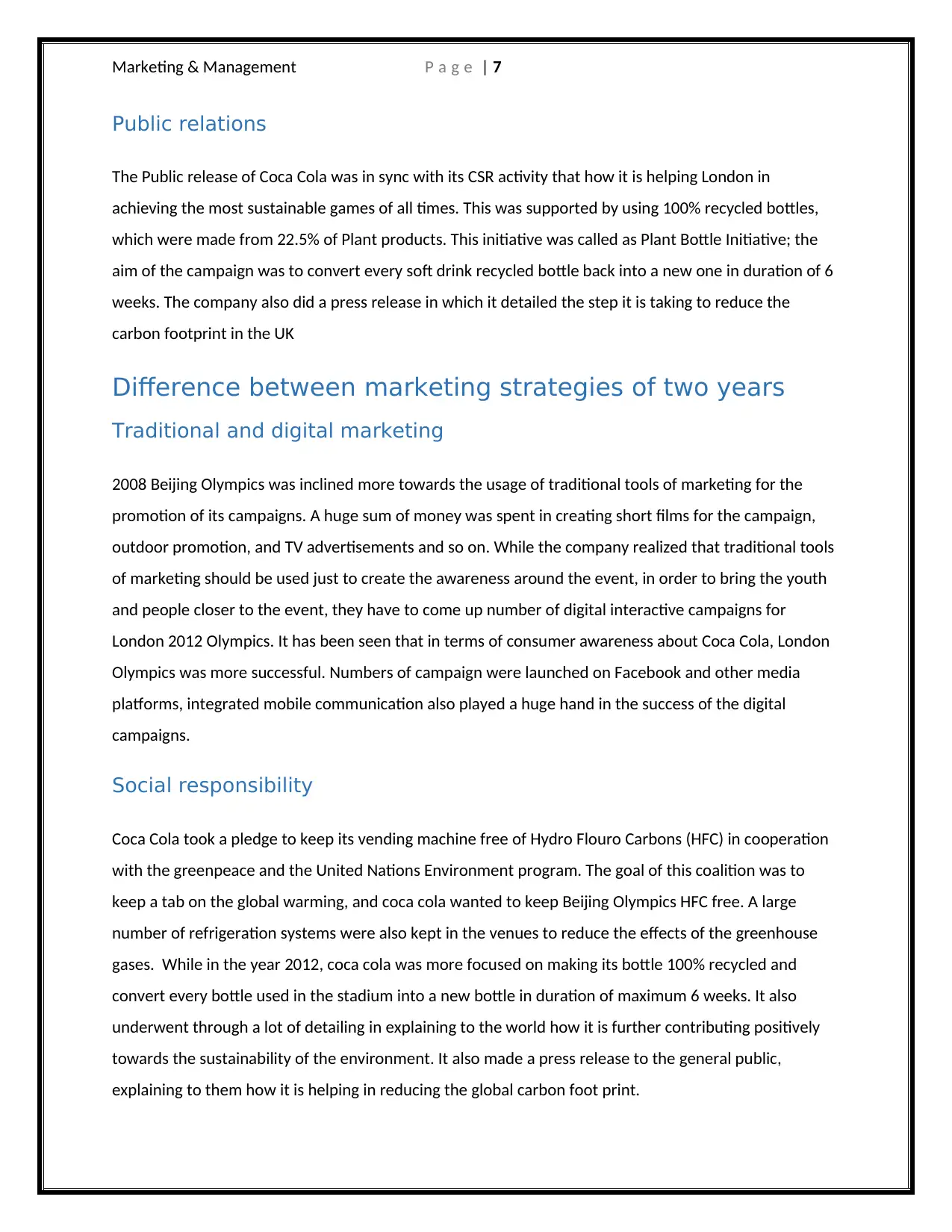
Marketing & Management P a g e | 7
Public relations
The Public release of Coca Cola was in sync with its CSR activity that how it is helping London in
achieving the most sustainable games of all times. This was supported by using 100% recycled bottles,
which were made from 22.5% of Plant products. This initiative was called as Plant Bottle Initiative; the
aim of the campaign was to convert every soft drink recycled bottle back into a new one in duration of 6
weeks. The company also did a press release in which it detailed the step it is taking to reduce the
carbon footprint in the UK
Difference between marketing strategies of two years
Traditional and digital marketing
2008 Beijing Olympics was inclined more towards the usage of traditional tools of marketing for the
promotion of its campaigns. A huge sum of money was spent in creating short films for the campaign,
outdoor promotion, and TV advertisements and so on. While the company realized that traditional tools
of marketing should be used just to create the awareness around the event, in order to bring the youth
and people closer to the event, they have to come up number of digital interactive campaigns for
London 2012 Olympics. It has been seen that in terms of consumer awareness about Coca Cola, London
Olympics was more successful. Numbers of campaign were launched on Facebook and other media
platforms, integrated mobile communication also played a huge hand in the success of the digital
campaigns.
Social responsibility
Coca Cola took a pledge to keep its vending machine free of Hydro Flouro Carbons (HFC) in cooperation
with the greenpeace and the United Nations Environment program. The goal of this coalition was to
keep a tab on the global warming, and coca cola wanted to keep Beijing Olympics HFC free. A large
number of refrigeration systems were also kept in the venues to reduce the effects of the greenhouse
gases. While in the year 2012, coca cola was more focused on making its bottle 100% recycled and
convert every bottle used in the stadium into a new bottle in duration of maximum 6 weeks. It also
underwent through a lot of detailing in explaining to the world how it is further contributing positively
towards the sustainability of the environment. It also made a press release to the general public,
explaining to them how it is helping in reducing the global carbon foot print.
Public relations
The Public release of Coca Cola was in sync with its CSR activity that how it is helping London in
achieving the most sustainable games of all times. This was supported by using 100% recycled bottles,
which were made from 22.5% of Plant products. This initiative was called as Plant Bottle Initiative; the
aim of the campaign was to convert every soft drink recycled bottle back into a new one in duration of 6
weeks. The company also did a press release in which it detailed the step it is taking to reduce the
carbon footprint in the UK
Difference between marketing strategies of two years
Traditional and digital marketing
2008 Beijing Olympics was inclined more towards the usage of traditional tools of marketing for the
promotion of its campaigns. A huge sum of money was spent in creating short films for the campaign,
outdoor promotion, and TV advertisements and so on. While the company realized that traditional tools
of marketing should be used just to create the awareness around the event, in order to bring the youth
and people closer to the event, they have to come up number of digital interactive campaigns for
London 2012 Olympics. It has been seen that in terms of consumer awareness about Coca Cola, London
Olympics was more successful. Numbers of campaign were launched on Facebook and other media
platforms, integrated mobile communication also played a huge hand in the success of the digital
campaigns.
Social responsibility
Coca Cola took a pledge to keep its vending machine free of Hydro Flouro Carbons (HFC) in cooperation
with the greenpeace and the United Nations Environment program. The goal of this coalition was to
keep a tab on the global warming, and coca cola wanted to keep Beijing Olympics HFC free. A large
number of refrigeration systems were also kept in the venues to reduce the effects of the greenhouse
gases. While in the year 2012, coca cola was more focused on making its bottle 100% recycled and
convert every bottle used in the stadium into a new bottle in duration of maximum 6 weeks. It also
underwent through a lot of detailing in explaining to the world how it is further contributing positively
towards the sustainability of the environment. It also made a press release to the general public,
explaining to them how it is helping in reducing the global carbon foot print.
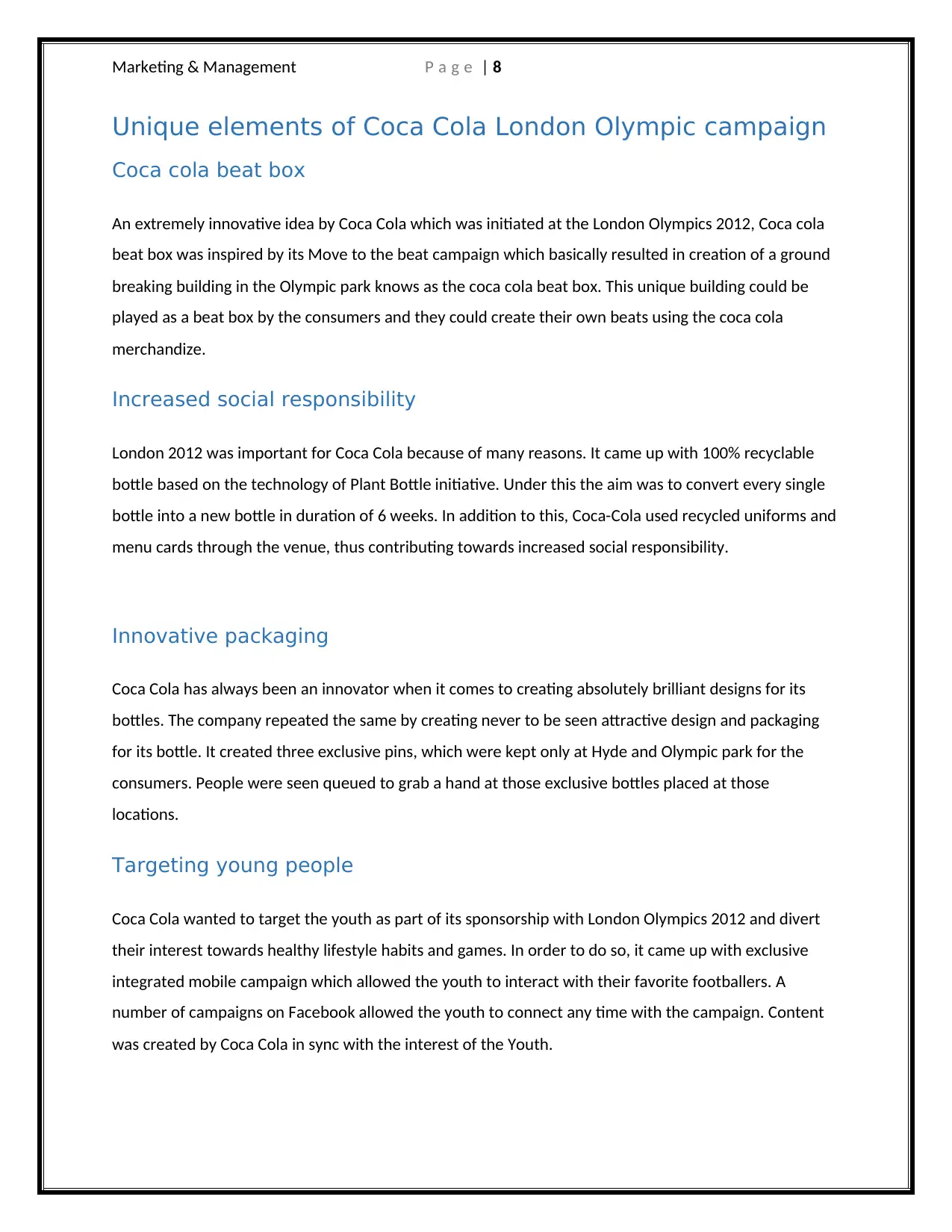
Marketing & Management P a g e | 8
Unique elements of Coca Cola London Olympic campaign
Coca cola beat box
An extremely innovative idea by Coca Cola which was initiated at the London Olympics 2012, Coca cola
beat box was inspired by its Move to the beat campaign which basically resulted in creation of a ground
breaking building in the Olympic park knows as the coca cola beat box. This unique building could be
played as a beat box by the consumers and they could create their own beats using the coca cola
merchandize.
Increased social responsibility
London 2012 was important for Coca Cola because of many reasons. It came up with 100% recyclable
bottle based on the technology of Plant Bottle initiative. Under this the aim was to convert every single
bottle into a new bottle in duration of 6 weeks. In addition to this, Coca-Cola used recycled uniforms and
menu cards through the venue, thus contributing towards increased social responsibility.
Innovative packaging
Coca Cola has always been an innovator when it comes to creating absolutely brilliant designs for its
bottles. The company repeated the same by creating never to be seen attractive design and packaging
for its bottle. It created three exclusive pins, which were kept only at Hyde and Olympic park for the
consumers. People were seen queued to grab a hand at those exclusive bottles placed at those
locations.
Targeting young people
Coca Cola wanted to target the youth as part of its sponsorship with London Olympics 2012 and divert
their interest towards healthy lifestyle habits and games. In order to do so, it came up with exclusive
integrated mobile campaign which allowed the youth to interact with their favorite footballers. A
number of campaigns on Facebook allowed the youth to connect any time with the campaign. Content
was created by Coca Cola in sync with the interest of the Youth.
Unique elements of Coca Cola London Olympic campaign
Coca cola beat box
An extremely innovative idea by Coca Cola which was initiated at the London Olympics 2012, Coca cola
beat box was inspired by its Move to the beat campaign which basically resulted in creation of a ground
breaking building in the Olympic park knows as the coca cola beat box. This unique building could be
played as a beat box by the consumers and they could create their own beats using the coca cola
merchandize.
Increased social responsibility
London 2012 was important for Coca Cola because of many reasons. It came up with 100% recyclable
bottle based on the technology of Plant Bottle initiative. Under this the aim was to convert every single
bottle into a new bottle in duration of 6 weeks. In addition to this, Coca-Cola used recycled uniforms and
menu cards through the venue, thus contributing towards increased social responsibility.
Innovative packaging
Coca Cola has always been an innovator when it comes to creating absolutely brilliant designs for its
bottles. The company repeated the same by creating never to be seen attractive design and packaging
for its bottle. It created three exclusive pins, which were kept only at Hyde and Olympic park for the
consumers. People were seen queued to grab a hand at those exclusive bottles placed at those
locations.
Targeting young people
Coca Cola wanted to target the youth as part of its sponsorship with London Olympics 2012 and divert
their interest towards healthy lifestyle habits and games. In order to do so, it came up with exclusive
integrated mobile campaign which allowed the youth to interact with their favorite footballers. A
number of campaigns on Facebook allowed the youth to connect any time with the campaign. Content
was created by Coca Cola in sync with the interest of the Youth.
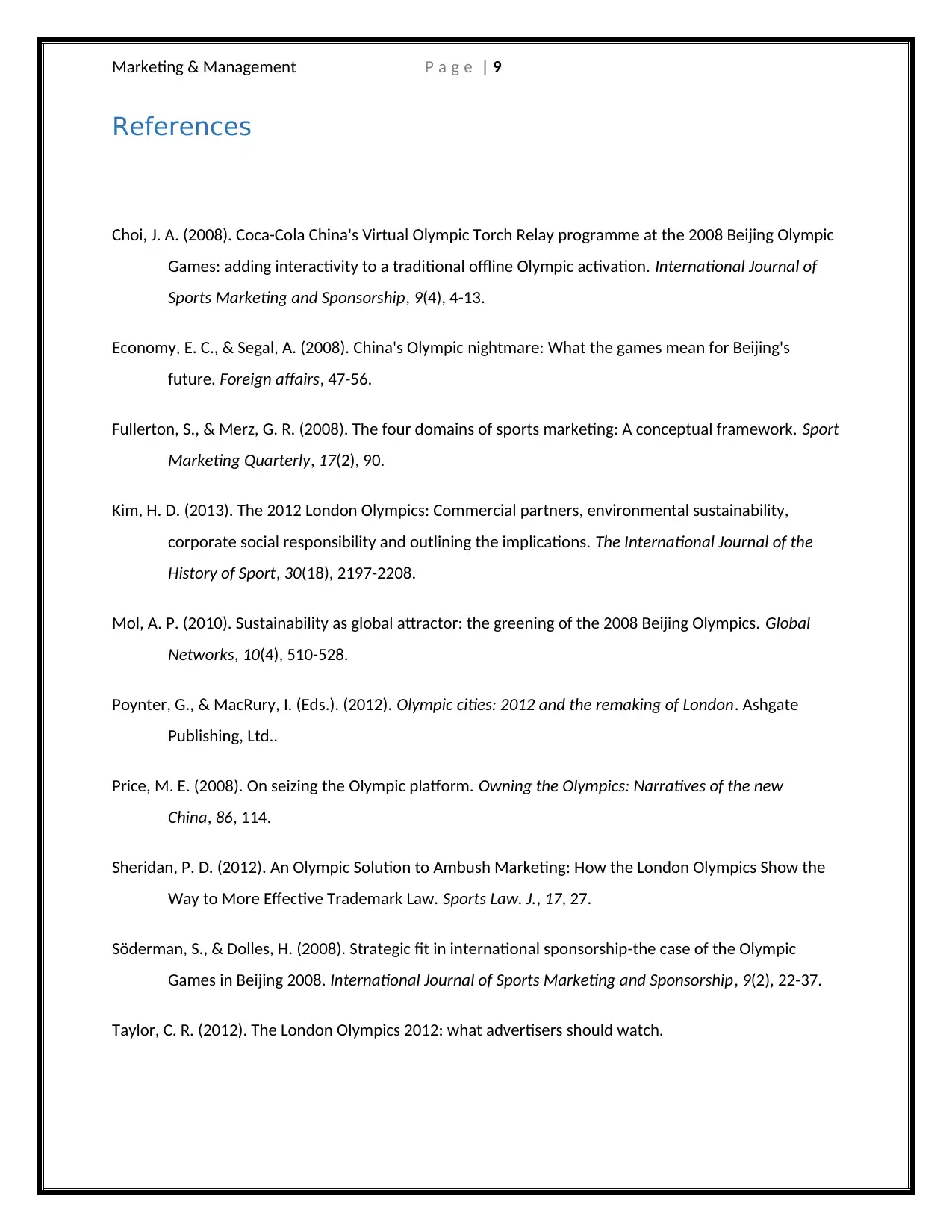
Marketing & Management P a g e | 9
References
Choi, J. A. (2008). Coca-Cola China's Virtual Olympic Torch Relay programme at the 2008 Beijing Olympic
Games: adding interactivity to a traditional offline Olympic activation. International Journal of
Sports Marketing and Sponsorship, 9(4), 4-13.
Economy, E. C., & Segal, A. (2008). China's Olympic nightmare: What the games mean for Beijing's
future. Foreign affairs, 47-56.
Fullerton, S., & Merz, G. R. (2008). The four domains of sports marketing: A conceptual framework. Sport
Marketing Quarterly, 17(2), 90.
Kim, H. D. (2013). The 2012 London Olympics: Commercial partners, environmental sustainability,
corporate social responsibility and outlining the implications. The International Journal of the
History of Sport, 30(18), 2197-2208.
Mol, A. P. (2010). Sustainability as global attractor: the greening of the 2008 Beijing Olympics. Global
Networks, 10(4), 510-528.
Poynter, G., & MacRury, I. (Eds.). (2012). Olympic cities: 2012 and the remaking of London. Ashgate
Publishing, Ltd..
Price, M. E. (2008). On seizing the Olympic platform. Owning the Olympics: Narratives of the new
China, 86, 114.
Sheridan, P. D. (2012). An Olympic Solution to Ambush Marketing: How the London Olympics Show the
Way to More Effective Trademark Law. Sports Law. J., 17, 27.
Söderman, S., & Dolles, H. (2008). Strategic fit in international sponsorship-the case of the Olympic
Games in Beijing 2008. International Journal of Sports Marketing and Sponsorship, 9(2), 22-37.
Taylor, C. R. (2012). The London Olympics 2012: what advertisers should watch.
References
Choi, J. A. (2008). Coca-Cola China's Virtual Olympic Torch Relay programme at the 2008 Beijing Olympic
Games: adding interactivity to a traditional offline Olympic activation. International Journal of
Sports Marketing and Sponsorship, 9(4), 4-13.
Economy, E. C., & Segal, A. (2008). China's Olympic nightmare: What the games mean for Beijing's
future. Foreign affairs, 47-56.
Fullerton, S., & Merz, G. R. (2008). The four domains of sports marketing: A conceptual framework. Sport
Marketing Quarterly, 17(2), 90.
Kim, H. D. (2013). The 2012 London Olympics: Commercial partners, environmental sustainability,
corporate social responsibility and outlining the implications. The International Journal of the
History of Sport, 30(18), 2197-2208.
Mol, A. P. (2010). Sustainability as global attractor: the greening of the 2008 Beijing Olympics. Global
Networks, 10(4), 510-528.
Poynter, G., & MacRury, I. (Eds.). (2012). Olympic cities: 2012 and the remaking of London. Ashgate
Publishing, Ltd..
Price, M. E. (2008). On seizing the Olympic platform. Owning the Olympics: Narratives of the new
China, 86, 114.
Sheridan, P. D. (2012). An Olympic Solution to Ambush Marketing: How the London Olympics Show the
Way to More Effective Trademark Law. Sports Law. J., 17, 27.
Söderman, S., & Dolles, H. (2008). Strategic fit in international sponsorship-the case of the Olympic
Games in Beijing 2008. International Journal of Sports Marketing and Sponsorship, 9(2), 22-37.
Taylor, C. R. (2012). The London Olympics 2012: what advertisers should watch.
1 out of 10
Your All-in-One AI-Powered Toolkit for Academic Success.
+13062052269
info@desklib.com
Available 24*7 on WhatsApp / Email
![[object Object]](/_next/static/media/star-bottom.7253800d.svg)
Unlock your academic potential
© 2024 | Zucol Services PVT LTD | All rights reserved.

